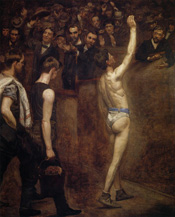| |  | Thomas Eakins |  |
| Thomas Eakins (1844-1916). Born in Philadelphia, he passed the major part of his life there with the exception of a period of training in Europe, 1866-70. He studied in Paris with Gérôme and Bonnat, but learnt most from the Spanish painters Velázquez and Ribera, absorbing a precise and uncompromising sense for actuality which he applied to portraiture and genre pictures of the life of his native city (boating and bathing were favorite themes). Eakins is regarded by most critics as the outstanding American painter of the 19th century and by many as the greatest his country has yet produced. |  | (read more ...)Thomas Eakins began teaching at the Pennsylvania Academy of Fine Arts in 1876 and was attacked for his radical ideas. In 1886 he was forced to resign after allowing a mixed class to draw from a completely nude male model. Eakins's quest for realism led him to study anatomy and make full use of Muybridge's photographic researches, but the scientific bent in his work is of less importance than his honesty and depth of characterization. His portraits are often compared to Rembrandt's because of their dramatic play of light and shadow and sense of inner truth. The most famous of his paintings is "The Gross Clinic", which aroused controversy because of its unsparing depiction of surgery, an experience that was repeated with "The Agnew Clinic". Because of financial support from his father, Eakins could continue on his chosen course despite public abuse, but much of his later career was spent working in bitter isolation. It was only near the end of his life that he achieved recognition as a great master, and in the first two decades of the 20th century his desire to 'peer deeper into the heart of American life' was reflected in the work of the Ash-can School and other Realist painters. As well as being a painter and photographer, Eakins also made a few sculptures. His wife, Susan Hannah Macdowell Eakins (1851-1938), whom he married in 1884, was also a painter and photographer, as well as an accomplished pianist. |
|
| |
|  | | "Max Schmitt in a Single Scull" (1871) Oil on canvas, 82.6 x 117.5 cm - 32 1/2 x 46 1/4 in. The Metropolitan Museum, New York, USA. | | |  | 
|  | | "The Biglen Brothers Racing" (1873) Oil on canvas, 91.75 x 61.27 cm - 36.1 x 24.1 in. National Gallery of Art, Washington, D.C., USA. | | | | 
|  | | "In the mid-time" Oil on canvas. Private collection. | | | | 
|  | | "Portrait of Amelia van Buren" (circa 1891) Oil on canvas. The Phillips Collection, Washington, D.C., USA. | | | | 
|  | | "An Actress" (1903) Oil on canvas. Philadelphia Museum of Art, Philadelphia, Pennsylvania, USA. | | | | 
|  | | "Home Ranch" (1892) Oil on canvas. Philadelphia Museum of Art, Philadelphia, Pennsylvania, USA. | | | | 
|  | | "Portrait of Leslie W. Miller" (1901) Oil on canvas. Philadelphia Museum of Art, Philadelphia, Pennsylvania, USA. | | | | 
|  | | "Baby at Play" (1876) Oil on canvas, 122.87 x 81.91 cm - 48.4 x 32.2 in. National Gallery of Art, Washington, D.C., USA. | | | | 
|  | | "Salutat" (1898) Oil on canvas. Addison Gallery of American Art, Andover, Massachussets, USA. | | | | 
|  | | "A May Morning in the Park" (1879-80) Oil on canvas, 91.44 x 60.32 cm - 36 x 23.7 in. Private collection. |
| Text source: 'Webmuseum' (www.ibiblio.org/wm). | |
|
|